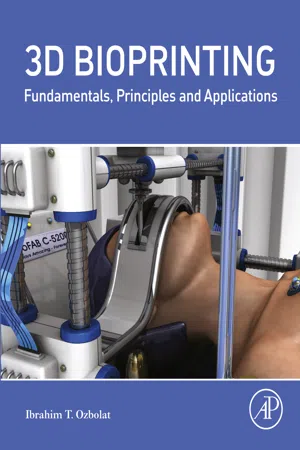
3D Bioprinting
Fundamentals, Principles and Applications
- 356 pages
- English
- ePUB (mobile friendly)
- Available on iOS & Android
3D Bioprinting
Fundamentals, Principles and Applications
About this book
3D Bioprinting: Fundamentals, Principles and Applications provides the latest information on the fundamentals, principles, physics, and applications of 3D bioprinting. It contains descriptions of the various bioprinting processes and technologies used in additive biomanufacturing of tissue constructs, tissues, and organs using living cells. The increasing availability and decreasing costs of 3D printing technologies are driving its use to meet medical needs, and this book provides an overview of these technologies and their integration. Each chapter discusses current limitations on the relevant technology, giving future perspectives.Professor Ozbolat has pulled together expertise from the fields of bioprinting, tissue engineering, tissue fabrication, and 3D printing in his inclusive table of contents. Topics covered include raw materials, processes, machine technology, products, applications, and limitations. The information in this book will help bioengineers, tissue and manufacturing engineers, and medical doctors understand the features of each bioprinting process, as well as bioink and bioprinter types. In addition, the book presents tactics that can be used to select the appropriate process for a given application, such as tissue engineering and regenerative medicine, transplantation, clinics, or pharmaceutics.- Describes all aspects of the bioprinting process, from bioink processing through design for bioprinting, bioprinting techniques, bioprinter technologies, organ printing, applications, and future trends- Provides a detailed description of each bioprinting technique with an in-depth understanding of its process modeling, underlying physics and characteristics, suitable bioink and cell types printed, and major accomplishments achieved thus far- Explains organ printing technology in detail with a step-by-step roadmap for the 3D bioprinting of organs from isolating stem cells to the post-transplantation of organs- Presents tactics that can be used to select the appropriate process for a given application, such as tissue engineering and regenerative medicine, transplantation, clinics, or pharmaceutics
Frequently asked questions
- Essential is ideal for learners and professionals who enjoy exploring a wide range of subjects. Access the Essential Library with 800,000+ trusted titles and best-sellers across business, personal growth, and the humanities. Includes unlimited reading time and Standard Read Aloud voice.
- Complete: Perfect for advanced learners and researchers needing full, unrestricted access. Unlock 1.4M+ books across hundreds of subjects, including academic and specialized titles. The Complete Plan also includes advanced features like Premium Read Aloud and Research Assistant.
Please note we cannot support devices running on iOS 13 and Android 7 or earlier. Learn more about using the app.
Information
Introduction
Abstract
Keywords
1.1. Tissue Engineering
1.2. Three-Dimensional Printing in Tissue Engineering
1.3. Three-Dimensional Bioprinting
Table of contents
- Cover image
- Title page
- Table of Contents
- Dedication
- Copyright
- About the Author
- Preface
- Acknowledgments
- 1. Introduction
- 2. Design for Bioprinting
- 3. The Bioink
- 4. Extrusion-Based Bioprinting
- 5. Droplet-Based Bioprinting
- 6. Laser-Based Bioprinting
- 7. Bioprinter Technologies
- 8. Roadmap to Organ Printing
- 9. Applications of 3D Bioprinting
- 10. Future Trends
- Index